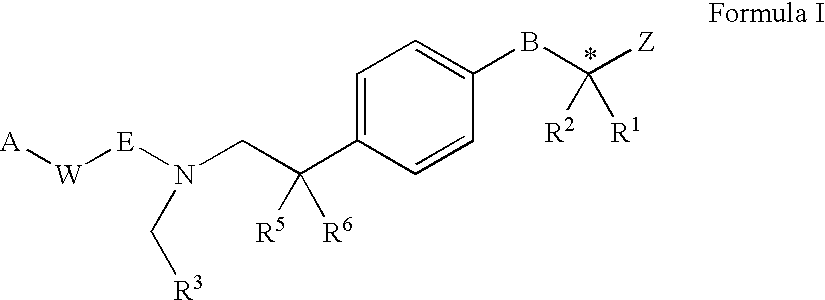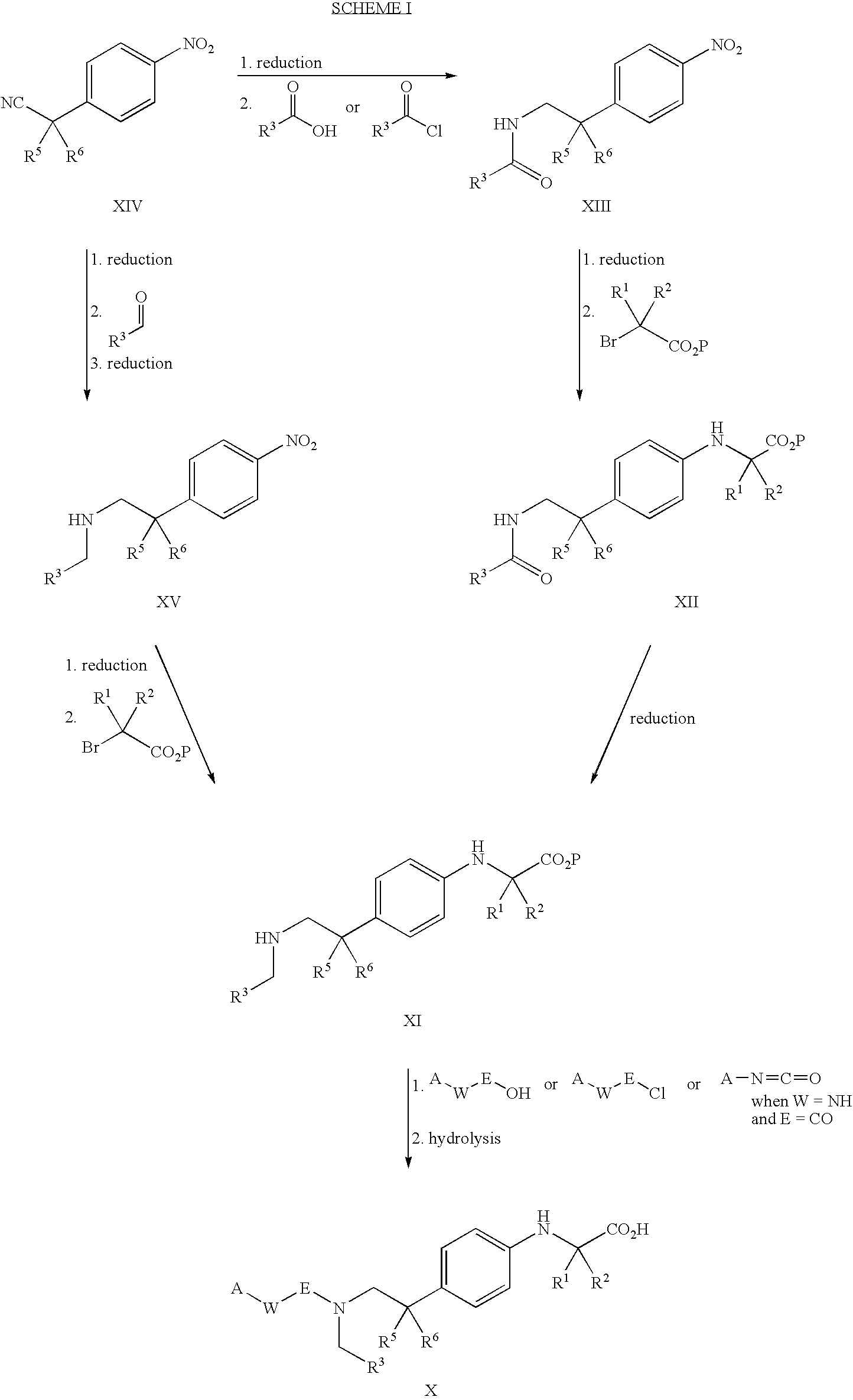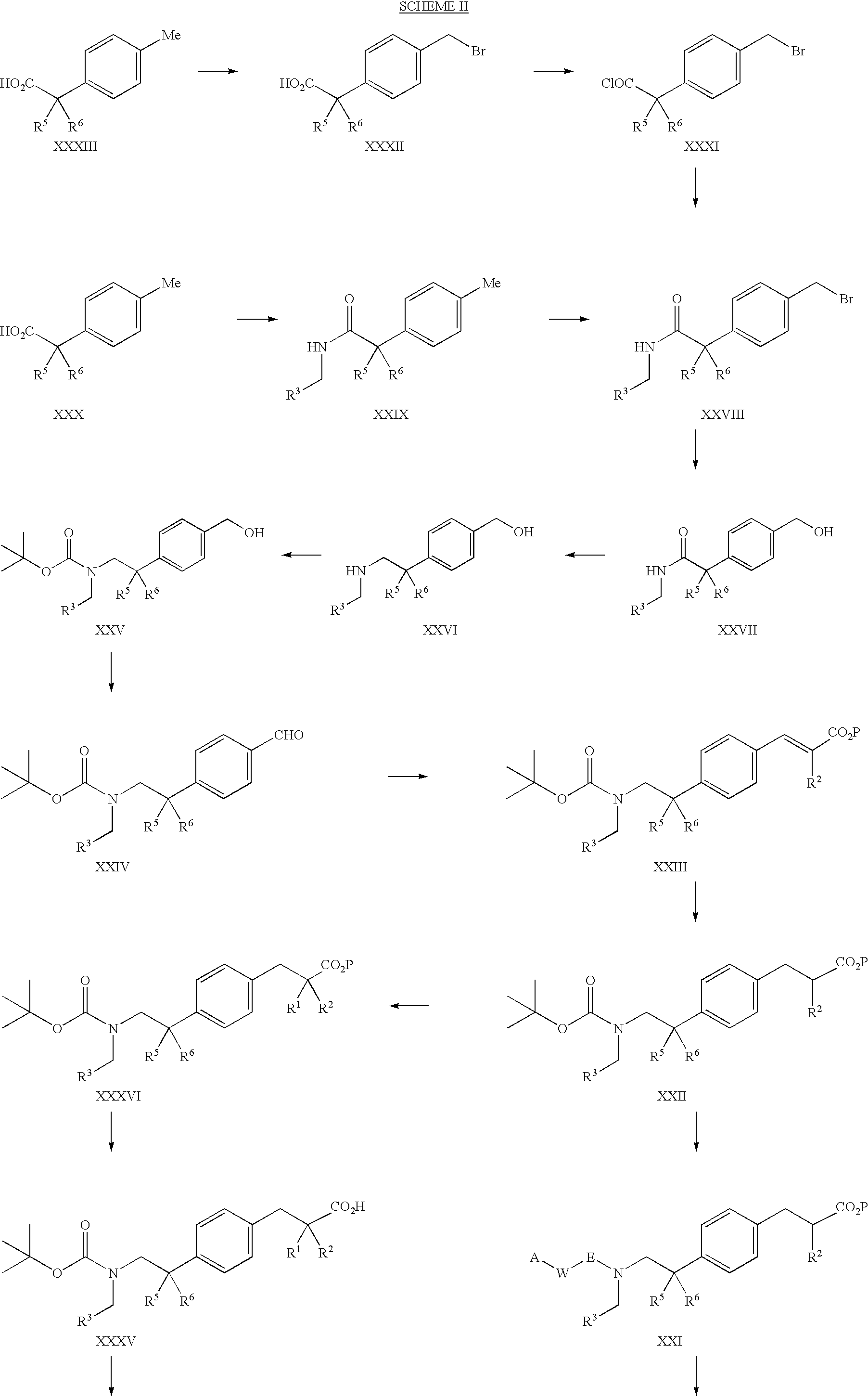PPAR agonists
a technology of proliferator activator and agonist, which is applied in the direction of drug composition, metabolic disorder, cardiovascular disorder, etc., can solve the problems of limiting the use of hypoglycemic agents, large segments of western populations are now realized to be at particularly high risk, and clinically available hypoglycemic agents can have side effects
- Summary
- Abstract
- Description
- Claims
- Application Information
AI Technical Summary
Benefits of technology
Problems solved by technology
Method used
Image
Examples
example 2
N-Heptyl-2-(4-hydroxymethyl-phenyl)-acetamide:
A stirred solution of (4-bromomethyl-phenyl)acetic acid (80.0 mmol, 12.0 g) and thionyl chloride (240 mmol, 17.5 mL) in chloroform (200 mL) under a nitrogen atmosphere was heated under reflux for 16 hours. The solution was cooled to room temperature and concentrated under reduced pressure to a white solid. The solid was dissolved in dichloromethane and added dropwise to a solution of 1-heptylamine (95.9 mmol, 14.2 mL) and N,N-diisopropylethylamine (95.9 mmol, 16.7 mL) in dichloromethane (100 mL) cooled to 0.degree. C. The resulting solution was stirred at room temperature for 25 minutes. The mixture was poured over 1N HCl, and the aqueous layer was extracted with dichloromethane (2.times.). The organic layers were combined, washed with 2N HCl (2.times.), brine (1.times.), dried over anhydrous sodium sulfate and concentrated to give a white solid. A stirred solution of this solid (.about.24.7 mmol, 7.5 g) and CaCO.sub.3 (120 mmol, 12.0 g)...
example 3
[4-(2-Heptylamino-ethyl)-phenyl]-methanol:
To a stirred solution of N-heptyl-2-(4-hydroxymethyl-phenyl)-acetamide (5.6 mmol, 1.48 g) dissolved in tetrahydrofuran (15 mL) under a nitrogen atmosphere at 0.degree. C. was added sodium borohydride (16.9 mmol, 639 mg) followed by the dropwise addition of boron trifluoride diethyletherate (22.5 mmol, 2.85 mL). The mixture was allowed to stir at room temperature for 11 hours. The reaction was quenched by the cautious addition of 2N HCl until gas evolution had ceased. The resulting mixture was refluxed for 45 minutes, cooled to room temperature and concentrated to a white solid. The solid was dissolved in water, then brought to pH 14 with 2N NaOH. The aqueous solution was extracted with diethyl ether (3.times.). The organic layers were combined, washed with brine (1.times.), dried over anhydrous sodium sulfate and concentrated to give [4-(2-heptylamino-ethyl)-phenyl]-methanol as a clear oil (1.37 g, 98%).
.sup.1 H NMR .delta.(CDCl.sub.3): 7.27...
example 4
Heptyl-[2-(4-hydroxymethyl-phenyl)-ethyl]-carbamic acid tert-butyl ester:
To a beaker containing saturated NaHCO.sub.3 (20 mL) and [4-(2-heptylamino-ethyl)-phenyl]-methanol (5.5 mmol, 1.2 g) dissolved in tetrahydrofuran (8 mL) was added di-tert-butyl dicarbonate (5.5 mmol, 1.2 g). To the solution was added 2M NaOH to maintain the pH of the solution between 8 and 9. After the pH of the solution became stable, the mixture was extracted with diethyl ether (3.times.). The organic layers were combined, dried over anhydrous sodium sulfate, and concentrated to a clear oil. The crude product was purified by flash chromatography (Merck silica gel 60, art#9385-3) eluting with 10% methanol / methylene chloride to give the heptyl-[2-(4-hydroxymethyl-phenyl)-ethyl]-carbamic acid tert-butyl ester as a colorless oil (1.70 g, 89%).
.sup.1 H NMR .delta.(CDCl.sub.3): 7.28 (d, J=7.89 Hz, 2H); 7.17 (br.s, 2H); 4.64 (d, J=5.81 Hz, 2H); 3.33 (br.s, 2H); 3.20-3.00 (m, 2H); 2.87-2.73 (br.s, 2H); 1.68 (t, J=5.9...
PUM
| Property | Measurement | Unit |
|---|---|---|
| temperature | aaaaa | aaaaa |
| temperature | aaaaa | aaaaa |
| temperature | aaaaa | aaaaa |
Abstract
Description
Claims
Application Information
 Login to View More
Login to View More - R&D
- Intellectual Property
- Life Sciences
- Materials
- Tech Scout
- Unparalleled Data Quality
- Higher Quality Content
- 60% Fewer Hallucinations
Browse by: Latest US Patents, China's latest patents, Technical Efficacy Thesaurus, Application Domain, Technology Topic, Popular Technical Reports.
© 2025 PatSnap. All rights reserved.Legal|Privacy policy|Modern Slavery Act Transparency Statement|Sitemap|About US| Contact US: help@patsnap.com



